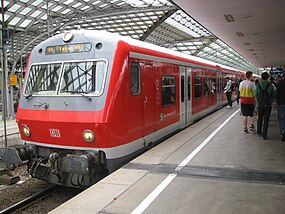Rhine-Ruhr S-Bahn
| S-Bahn Rhein-Ruhr S-Bahn Rhein-Sieg / S-Bahn Köln | |||
|---|---|---|---|
 | |||
 X-Wagen coaches at Köln Hauptbahnhof | |||
| Overview | |||
| Locale | Rhine-Ruhr, North Rhine-Westphalia, Germany | ||
| Transit type | S-train | ||
| Number of lines | 13 | ||
| Number of stations | 124 | ||
| Annual ridership | 130 million Düsseldorf/Rhine-Ruhr: 98 million[1] Cologne: 32 million[2] | ||
| Headquarters | Düsseldorf, Germany | ||
| Website | www.s-bahn-rhein-ruhr.de www.s-bahn-koeln.de | ||
| Operation | |||
| Began operation | 1967 | ||
| Operator(s) | |||
| Headway | 20 min. | ||
| Technical | |||
| System length | 676 km (420.05 mi) | ||
| |||
The Rhine-Ruhr S-Bahn (German: S-Bahn Rhein-Ruhr) is a polycentric and electrically driven S-train network covering the Rhine-Ruhr Metropolitan Region in the German federal state of North Rhine-Westphalia. This includes most of the Ruhr (and cities such as Dortmund, Duisburg and Essen), the Berg cities of Wuppertal and Solingen and parts of the Rhineland (with cities such as Cologne and Düsseldorf). The easternmost city within the S-Bahn Rhine-Ruhr network is Unna, the westernmost city served is Mönchengladbach.
The S-Bahn operates in the areas of the Verkehrsverbund Rhein-Ruhr (VRR) and Verkehrsverbund Rhein-Sieg (VRS) tariff associations, touching areas of Aachener Verkehrsverbund at Düren and Verkehrsgemeinschaft Ruhr-Lippe at Unna. The network was established in 1967 with a line connecting Ratingen Ost to Düsseldorf-Garath. Currently, the system consists of 13 lines (11 lines operated by DB Regio NRW, S28 operated by Regiobahn and S7 operated by Abellio Rail NRW). The S13/S19 runs 24/7 between Cologne Hbf and Cologne/Bonn Flughafen.
History

The predecessor of the S-Bahn was the so-called Bezirksschnellverkehr between the cities of Düsseldorf and Essen, which consisted of steam-powered push-pull trains, mainly hauled by Class 78 and Class 65 engines.
The first S-Bahn lines were operated using Silberling cars and Class 141 locomotives, however these were not suited for operations on an urban network and were soon replaced by Class 420 electric multiple units. In the mid-1970s, the Class 420 was decided to be unsuitable for the network as well[citation needed], mainly due to being uncomfortable and lacking a lavatory[citation needed], since one could travel rather long distances on the Rhine-Ruhr network, which wasn't the case on the Munich S-Bahn for which the class 420 were originally designed. At first an improved version of the 420, the Class 422, was discussed, but in 1978 the Deutsche Bundesbahn commissioned a batch of coaches from Duewag and MBB, called the x-Wagen (the x-car) after its classification code Bx. In late 1978, the first prototypes (the 2nd class cars of type Bx 794.0 and the cab car Bxf 796.0) were handed over to the DB, the 1st/2nd class cars ABx 791.0 following in early 1979. The prototypes were successful, and so from 1981 to 1994 several series were commissioned, first to be hauled by the Class 111 engines, but after the German reunification the surplus Reichsbahn engines of Class 143 replaced the 111s on the S-Bahn network.
Rolling stock today


On much of the network, Class 143 locomotives are used along with the specially developed Bx (second class) and ABx (second and first class) cars and cab cars (Bxf). The Class 420 electric multiple units previously belonging to the Munich, Stuttgart and Frankfurt networks which had operated the S7 and S9 services were finally retired at the beginning of 2009, and have been replaced with the new DBAG Class 422, while Class 423 EMUs can be found on the S11, S12 and S13 lines. The S28 is not operated by DB Regio NRW, but by the Regiobahn, which uses Bombardier TALENT DMUs on the line. The S7 uses Alstom Coradia LINT DMUs while operated by Abellio Rail NRW. New rolling stock for the S5 and S8 lines was introduced in December 2014 after being tested on the S68 since October 2014. These Alstom Coradia trains are operated by DB Regio NRW, a special feature of these trainsets are on-board toilets.
All trains of Rhine-Ruhr S-Bahn run with the red DB livery except for the S7 and S28 trainsets which are painted in the colours of their operators. In 2019, there will be a major operator change: Several lines will no longer be operated by DB Regio NRW but by Abellio Rail NRW and Eurobahn.[3] Simultaneously, the livery of the trains will change to a green-white livery to keep a uniform appearance although the trains will be run by different operators.[4]
Lines
The region's lines were mainly built by three railway companies (the Cologne-Minden Railway Company, the Bergisch-Märkische Railway Company and the Rhenish Railway Company), giving the Rhine-Ruhr S-Bahn a variety of lines to use for its routes. This means that the S-Bahn lines use up to five different railways to run over.
Kursbuchstrecken 450.x (x is equivalent to the number of the line), as of 13 December 2009.
See also
References
- ^ Press note Deutsche Bahn, 28. January 2011
- ^ Facts and figures Archived 2011-07-06 at the Wayback Machine S-Bahn Köln
- ^ Koch, Hildegard Braun, Oliver (2016-07-07). "Deutsche Bahn verliert acht VRR-Linien im Ruhrgebiet" (in German). Retrieved 2017-01-28.
{{cite news}}: CS1 maint: multiple names: authors list (link) - ^ "VRR: Heute S-Bahnvergabeentscheidung - BAHN[berufe]". www.bahnberufe.de (in German). Retrieved 2017-01-28.
- ^ a b "S-Bahn Rhein-Ruhr-Sieg - Geschichte" (in German). www.indusi.de. Retrieved 25 August 2011.

